-
Countries
-
Data and Analysis
-
Special Focus
-
Crisis Responses
Event Tracking
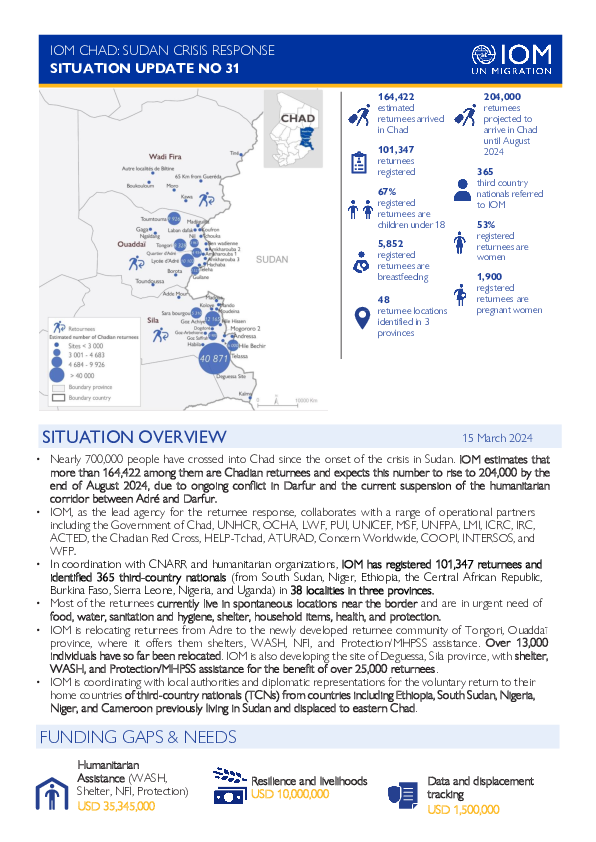
Contact
DTM Chad, dtmtchad@iom.int
Language
English
Location
Chad
Period Covered
Feb 25 2024
May 13 2024
Activity
- Mobility Tracking
- Event Tracking
• Nearly 700,000 people have crossed into Chad since the onset of the crisis in Sudan. IOM estimates that more than 164,422 among them are Chadian returnees and expects this number to rise to 204,000 by the end of August 2024, due to ongoing conflict in Darfur and the current suspension of the humanitarian corridor between Adré and Darfur.
• IOM, as the lead agency for the returnee response, collaborates with a range of operational partners including the Government of Chad, UNHCR, OCHA, LWF, PUI, UNICEF, MSF, UNFPA, LMI, ICRC, IRC, ACTED, the Chadian Red Cross, HELP-Tchad, ATURAD, Concern Worldwide, COOPI, INTERSOS, and WFP.
• In coordination with CNARR and humanitarian organizations, IOM has registered 101,347 returnees and identified 365 third-country nationals (from South Sudan, Niger, Ethiopia, the Central African Republic, Burkina Faso, Sierra Leone, Nigeria, and Uganda) in 38 localities in three provinces.
• Most of the returnees currently live in spontaneous locations near the border and are in urgent need of food, water, sanitation and hygiene, shelter, household items, health, and protection.
• IOM is relocating returnees from Adre to the newly developed returnee community of Tongori, Ouaddaï province, where it offers them shelters, WASH, NFI, and Protection/MHPSS assistance. Over 13,000 individuals have so far been relocated. IOM is also developing the site of Deguessa, Sila province, with shelter, WASH, and Protection/MHPSS assistance for the benefit of over 25,000 returnees.
• IOM is coordinating with local authorities and diplomatic representations for the voluntary return to their home countries of third-country nationals (TCNs) from countries including Ethiopia, South Sudan, Nigeria, Niger, and Cameroon previously living in Sudan and displaced to eastern Chad.

Contact
DTM Chad, dtmtchad@iom.int
Language
English
Location
Chad
Period Covered
Feb 25 2024
Mar 24 2024
Activity
- Mobility Tracking
- Event Tracking
•Nearly 700,000 people have crossed into Chad since the onset of the crisis in Sudan. IOM estimates that more than 164,422 among them are Chadian returnees and expects this number to rise to 204,000 by the end of August 2024, due to ongoing conflict in Darfur and the current suspension of the humanitarian corridor between Adré and Darfur.
• IOM, as the lead agency for the returnee response, collaborates with a range of operational partners including the Government of Chad, UNHCR, OCHA, LWF, PUI, UNICEF, MSF, UNFPA, LMI, ICRC, IRC, ACTED, the Chadian Red Cross, HELP-Tchad, ATURAD, Concern Worldwide, COOPI, INTERSOS, and WFP.
• In coordination with CNARR and humanitarian organizations, IOM has registered 110,958 returnees and identified 365 third-country nationals (from South Sudan, Niger, Ethiopia, the Central African Republic, Burkina Faso, Sierra Leone, Nigeria, and Uganda) in 38 localities in three provinces.
• Most of the returnees currently live in spontaneous locations near the border and are in urgent need of food, water, sanitation and hygiene, shelter, household items, health, and protection.
• IOM is relocating returnees from Adre to the newly developed returnee community of Tongori, Ouaddaï province, where it offers them shelters, WASH, NFI, and Protection/MHPSS assistance. Over 13,000 individuals have so far been relocated. IOM is also developing the site of Deguessa, Sila province, with shelter, WASH, and Protection/MHPSS assistance for the benefit of over 25,000 returnees.
• IOM is coordinating with local authorities and diplomatic representations for the voluntary return to their home countries of third-country nationals (TCNs) from countries including Ethiopia, South Sudan, Nigeria, Niger, and Cameroon previously living in Sudan and displaced to eastern Chad.
Contact
DTM Yemen, iomyemendtm@iom.int
Location
Yemen
Activity
- Mobility Tracking
- Event Tracking
Period Covered
Apr 14 2024 -Apr 20 2024
From 1 January to 20 April 2024, IOM Yemen DTM tracked 1,019 households (HH) (6,114 Individuals) who experienced displacement at least once.
Between 14 and 20 April 2024, IOM Yemen DTM tracked 44 households (264 individuals) displaced at least once. The majority of people moved into/within the following governorates and districts:
- Ma’rib (25 HHs) – Marib (14 HHs), Marib City (11 HH) districts. Most displacements in the governorate originated from Marib and Taiz.
- Ta’iz (13 HHs) – Al Makha (8 HHs), Jabal Habashi (5 HHs) districts. Most displacements in the governorate originated from Taiz and Ibb.
- Al Hodeidah (5 HHs) – Al Khukhah (3 HHs), Hays (2 HHs) districts. Most displacements in the governorate originated from Al Hodeidah and Taiz.
The majority of people moved from the following governorates and districts:
- Ta’iz (16 HHs) – Maqbanah (12 HHs), Sabir Al Mawadim (3 HHs), At Taiziyah (1 HH) districts.
- Ma’rib (8 HH) – Raghwan (3 HHs), Harib (2 HHs), Jabal Murad (1 HH) districts.
- Al Hodeidah (6 HH) – Al Jarrahi (3 HHs), Bajil (1 HH), Al Marawiah (1 HH) districts.
Population Groups
Survey Methodology
Unit of Analysis Or Observation
Type of Survey or Assessment
Keywords
Geographical Scope
Administrative boundaries with available data
The current dataset covers the following administrative boundaries
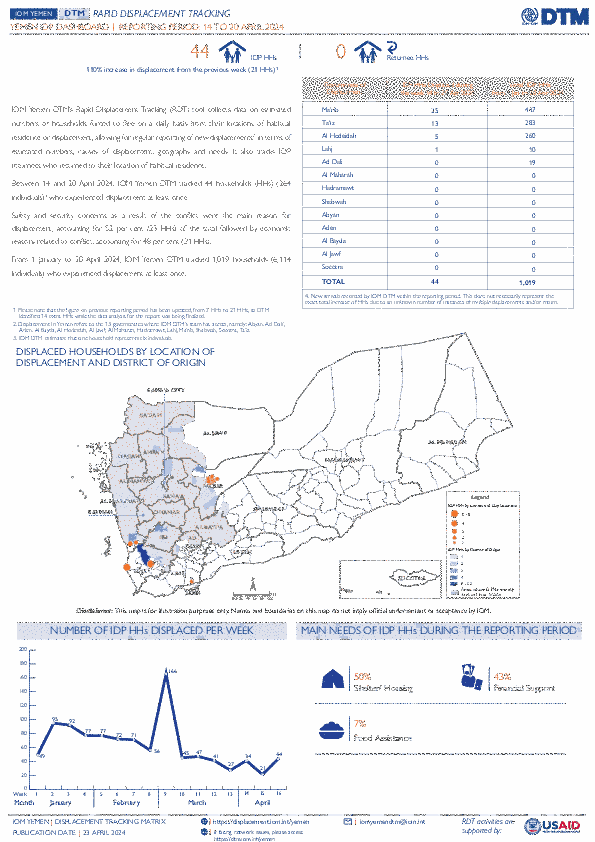
Contact
DTM Yemen, iomyemendtm@iom.int
Language
English
Location
Yemen
Period Covered
Apr 14 2024
Apr 20 2024
Activity
- Mobility Tracking
- Event Tracking
IOM Yemen DTM’s Rapid Displacement Tracking (RDT) tool collects data on estimated numbers of households forced to flee on a daily basis from their locations of origin or displacement, allowing for regular reporting of new displacements in terms of estimated numbers, geography, and needs. It also tracks returnees who returned to their location of origin.
From 1 January to 20 April 2024, IOM Yemen DTM tracked 1,019 households (HH) (6,114 Individuals) who experienced displacement at least once.
Between 14 and 20 April 2024, IOM Yemen DTM tracked 44 households (264 individuals) displaced at least once. The majority of people moved into/within the following governorates and districts:
- Ma’rib (25 HHs) – Marib (14 HHs), Marib City (11 HH) districts. Most displacements in the governorate originated from Marib and Taiz.
- Ta’iz (13 HHs) – Al Makha (8 HHs), Jabal Habashi (5 HHs) districts. Most displacements in the governorate originated from Taiz and Ibb.
- Al Hodeidah (5 HHs) – Al Khukhah (3 HHs), Hays (2 HHs) districts. Most displacements in the governorate originated from Al Hodeidah and Taiz.
The majority of people moved from the following governorates and districts:
- Ta’iz (16 HHs) – Maqbanah (12 HHs), Sabir Al Mawadim (3 HHs), At Taiziyah (1 HH) districts.
- Ma’rib (8 HH) – Raghwan (3 HHs), Harib (2 HHs), Jabal Murad (1 HH) districts.
- Al Hodeidah (6 HH) – Al Jarrahi (3 HHs), Bajil (1 HH), Al Marawiah (1 HH) districts.
IOM identified 14 households displaced in the previous reporting period, which covered 07 - 13 April 2024, in the governorates of Ma’rib (7 HHs), Al Hodeidah (6 HHs), and Taiz (1 HH). These figures have been added to the cumulative displacement total recorded since the beginning of the year.

Contact
DTM Nigeria, iomnigeriadtm@iom.int
Language
English
Location
Nigeria
Period Covered
Apr 15 2024
Apr 21 2024
Activity
- Mobility Tracking
- Event Tracking
On 16 and 20 April 2024, armed bandits attacked the communities of Gidan Dan Sale and Maitandu in Isa North ward, Chohi in Isa South ward, Sabon Gari Area in Tidibale ward and Babudole in Tsabre ward, all in Isa local government area (LGA) of Sokoto State and the community of Gidan Dan Zara in Galadima/Yanruwa ward of Zurmi LGA in Zamfara State. There were reports of 50 injuries and 37 fatalities. The attacks affected 5,639 individuals in 1,117 households and displaced 2,950 individuals to neighbouring communities and 2,689 individuals to Shinkafi town in Shinkafi North of Shinkafi LGA in Zamfara State. The displaced individuals included 3,159 children, 1,504 women and 976 men.
Of all the needs identified, food, non-food items (NFI) and shelter were the most prevalent. Other needs included security and water, sanitation and hygiene (WASH).
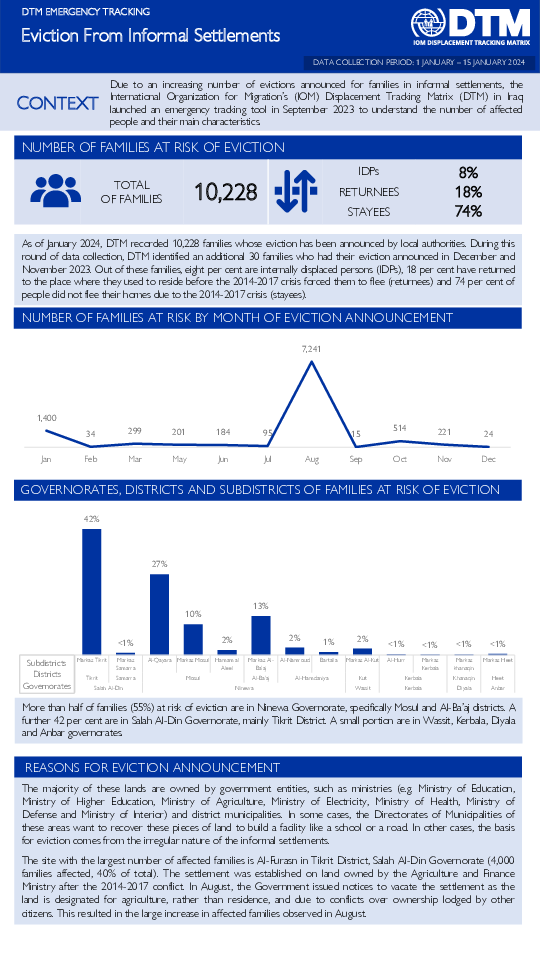
Contact
IraqDTM@iom.int
Language
English
Location
Iraq
Period Covered
Jan 01 2024
Jan 15 2024
Activity
- Mobility Tracking
- Event Tracking
Due to an increasing number of evictions announced for families in informal settlements, the International Organization for Migration’s (IOM) Displacement Tracking Matrix (DTM) in Iraq launched an emergency tracking tool in September 2023 to understand the number of affected people and their main characteristics.
This report presents the findings of the data collection in January 2024, where DTM recorded 10,228 families whose eviction has been announced by local authorities. During this round of data collection, DTM identified an additional 30 families who had their eviction announced in December and November 2023. Out of these families, 8 per cent are internally displaced persons (IDPs), 18 per cent have returned to the place where they used to reside before the 2014-2017 crisis forced them to flee (returnees) and 74 per cent of people did not flee their homes due to the 2014-2017 crisis (stayees)
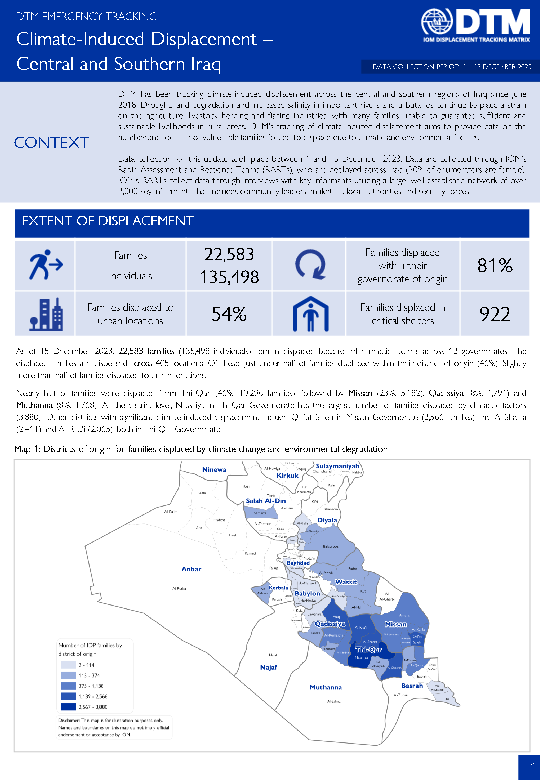
Contact
IraqDTM@iom.int
Language
English
Location
Iraq
Period Covered
Dec 01 2023
Dec 15 2023
Activity
- Mobility Tracking
- Event Tracking
The Climate induced displacement report measures climate-induced displacement across central and southern Iraq. Families included in these Emergency Tracking reports are those forced to move locations due to drought, water scarcity, environmental degradation and other climatic factors. As of 15 December 2023, 22,583 families (135,498 individuals) remain displaced because of climatic factors across 12 governorates. Of these, just under half of families are displaced within their district of origin (46%). Slightly more than half of families displaced to urban locations. The latest version of the report includes time trend analysis between 2016 and 2023, as well as a spotlight on those residing in critical shelters.
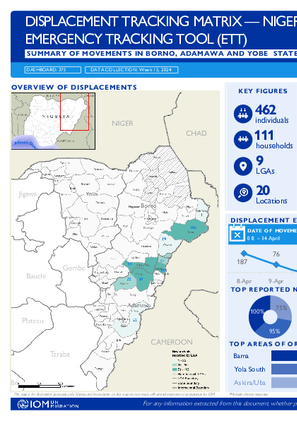
Contact
DTM Nigeria, iomnigeriadtm@iom.int
Language
English
Location
Nigeria
Period Covered
Apr 08 2024
Apr 14 2024
Activity
- Mobility Tracking
- Event Tracking
Between 8 and 14 April 2024, a total of 462 new arrivals were recorded at locations in Adamawa and Borno states. The new arrivals were recorded at locations in Askira/Uba, Bama, Gwoza, and Kala Balge Local Government Areas (LGAs) of the most conflict-affected Borno State, and in Fufore, Gombi, Hong, Madagali, and Michika LGAs of Adamawa State.
ETT assessments identified the following movement triggers: improved security (178 individuals or 38%), poor living conditions (124 individuals or 27%), family re-unification (88 individuals or 19%), seasonal farming (45 individuals or 10%), military operations (14 individuals or 3%) and fear of attack (13 individuals or 3%).
There was no movement recorded on 10 April 2024, as a result of the holiday marking the end of the Ramadan fast.
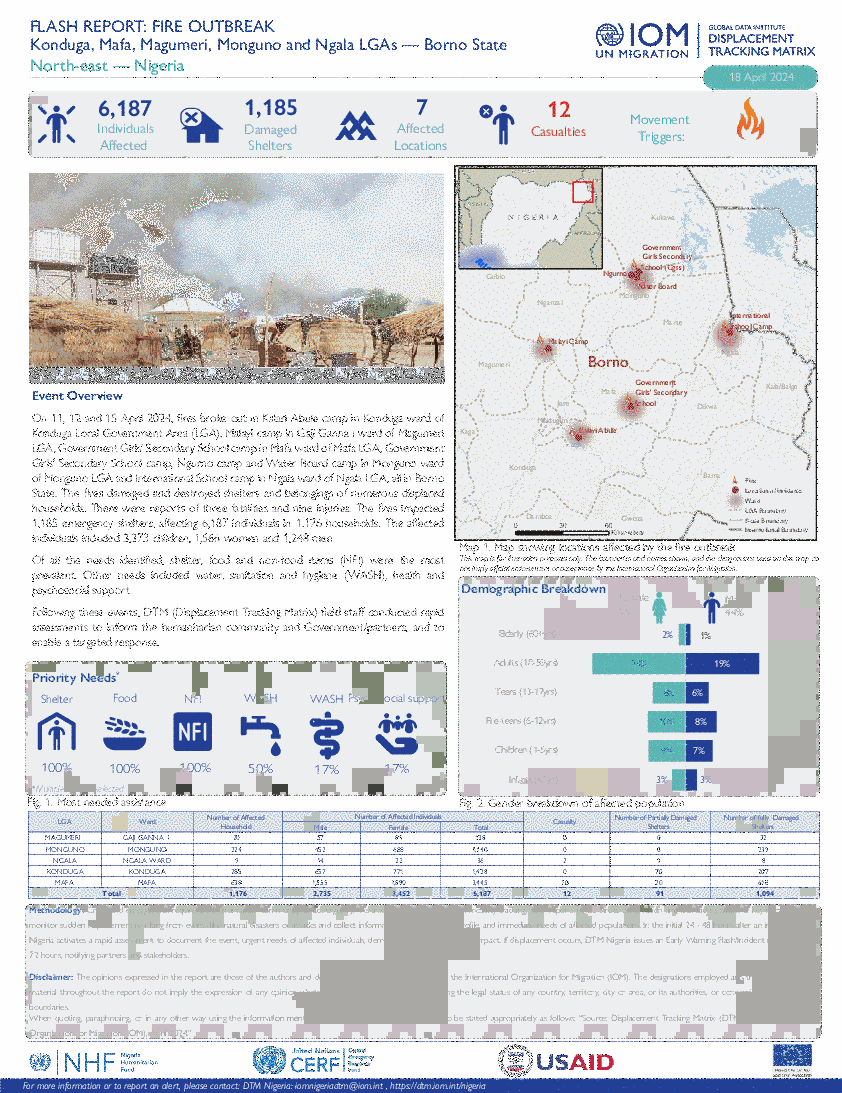
Contact
DTM Nigeria, iomnigeriadtm@iom.int
Language
English
Location
Nigeria
Period Covered
Apr 11 2024
Apr 15 2024
Activity
- Mobility Tracking
- Event Tracking
On 11, 12 and 15 April 2024, fires broke out in Kalari Abule camp in Konduga ward of Konduga Local Government Area (LGA), Malayi camp in Gaji Ganna I ward of Magumeri LGA, Government Girls’ Secondary School camp in Mafa ward of Mafa LGA, Government Girls’ Secondary School camp, Ngurno camp and Water Board camp in Monguno ward of Monguno LGA and International School camp in Ngala ward of Ngala LGA, all in Borno State. The fires damaged and destroyed shelters and belongings of numerous displaced households. There were reports of three fatalities and nine injuries. The fires impacted 1,185 emergency shelters, affecting 6,187 individuals in 1,176 households. The affected individuals included 3,373 children, 1,566 women and 1,248 men.

Contact
DTM Burundi, DTMBurundi@iom.int
Language
English
Location
Burundi
Period Covered
Apr 08 2024
Apr 15 2024
Activity
- Mobility Tracking
- Event Tracking
Le rapport DTM indique qu'entre le 8 et le 14 avril 2024, au Burundi, 13 674 personnes ont été affectées et 3 715 déplacées suite à des pluies torrentielles, des glissements de terrain, des inondations et des vents violents nécessitant une réponse immédiate de la communauté humanitaire. Parmi les affectés, 7 546 sont des femmes et 6 128 sont des hommes. La répartition par type d'urgence montre que les pluies torrentielles ont affecté 6 983 personnes et en ont déplacé 2 507, les glissements de terrain ont affecté 6 046 personnes et en ont déplacé 793, les inondations ont affecté 359 personnes et en ont déplacé 256, et les vents violents ont affecté 286 personnes et en ont déplacé 159. Les groupes vulnérables comprennent 122 femmes enceintes ou allaitantes, 3 hommes seuls chefs de ménage, 7 personnes avec une maladie chronique, 15 personnes handicapées et 10 personnes âgées vivant seules. Les dommages incluent de nombreuses habitations ainsi que des infrastructures telles que des écoles, des églises et des bâtiments administratifs. Cette situation met en lumière la nécessité d'une aide humanitaire continue et ciblée dans la région.
Pagination
- Previous page
- Page 34
- Next page
